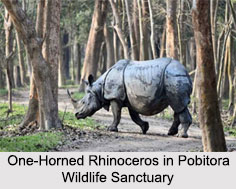 Pobitora Sanctuary is one of the most attractive and exciting sanctuaries of Assam located 35 km east of Guwahati. It is mostly popular for the highest concentration on the one-horned Rhinoceros in the world. The sanctuary is encompassed by Garanga Beel on the south and Brahmaputra River on the north. It is often referred to as the replica of Kaziranga National Park or its showroom. This wildlife sanctuary is one of the prominent spots for nature tourism in Assam. It is housed with a large number of wild animals, birds and reptiles and also some endangered species.
Pobitora Sanctuary is one of the most attractive and exciting sanctuaries of Assam located 35 km east of Guwahati. It is mostly popular for the highest concentration on the one-horned Rhinoceros in the world. The sanctuary is encompassed by Garanga Beel on the south and Brahmaputra River on the north. It is often referred to as the replica of Kaziranga National Park or its showroom. This wildlife sanctuary is one of the prominent spots for nature tourism in Assam. It is housed with a large number of wild animals, birds and reptiles and also some endangered species.
History of Pobitora Wildlife Sanctuary
Earlier Pobitora was the grazing reserve of the erstwhile Nagaon District of Assam in the flood plains of Brahmaputra River. It first came into popularity when the one-horned rhinoceros was first seen in this area during 1961-1962. In 1972 it was first declared as a Reserved Forest and then in 1987 as a Wildlife Sanctuary. This sanctuary is a remarkable one for its transformation from a grazing reserve to the habitat of one-horned rhinoceros.
Flora and Fauna of Pobitora Wildlife Sanctuary
Pobitora Sanctuary is also the abode of various categories of deer, apart from its steady count of Rhinos. Some wetlands of this area like the regions of Chitalmari, Tamuliduba and Dholi have become significant locations for Ferruginous Duck and number of migratory birds that often visit the area. Some other animals of this sanctuary are leopard, wild boar, Barking deer, wild buffalo, Asiatic buffalo, Chinese pangolins, civet cats etc. Pobitora Wildlife Sanctuary is the home to almost 7000 resident birds and 5000 migratory birds. It is also the abode of two critically endangered, four endangered, eight vulnerable and three near vulnerable threatened bird species. March Babbler, the most endemic bird species of Assam, is seen here. The water bodies or beels are the breeding places of different types of fishes. Rajamayong Hill, a part of the sanctuary also houses various species of leopards, lesser cats, barking deer etc.
 Rhinoceros of Pobitora Wildlife Sanctuary
Rhinoceros of Pobitora Wildlife Sanctuary
There are now around 93 rhinos in this sanctuary, which has got a ten percent increase over the last six years. This attracts the tourists of both domestic and foreign. These 93 rhinos are surviving on merely 16 square kilometer area of the park. This wildlife sanctuary is under the Indian Rhino Vision 2020. It is a joint programme of the Department of Environment and Forests under Government of Assam with the aid of World Wildlife Fund India (WWF India).
Other Activities around Pobitora Wildlife Sanctuary
Some other activities around Pobitora Wildlife Sanctuary for the visitors include visiting Haduk Hanging Bridge and Garanga Beel and enjoying the rural ambience of Mayong village, which is popular for its tradition of black magic.
Visiting Information on Pobitira Wildlife Sanctuary
The best time to visit the sanctuary is from November to April. It is closed from May to October due to monsoon. Pobitora can be reached via Guwahati or Jagiroad through National Highway 15. Guwahati and Jagiroad Railway Station are the nearest railheads to reach the park via trains. Nearest airport would be Lokpriya Gopinath Bordoloi International Airport located 75 km away from the range headquarters.











